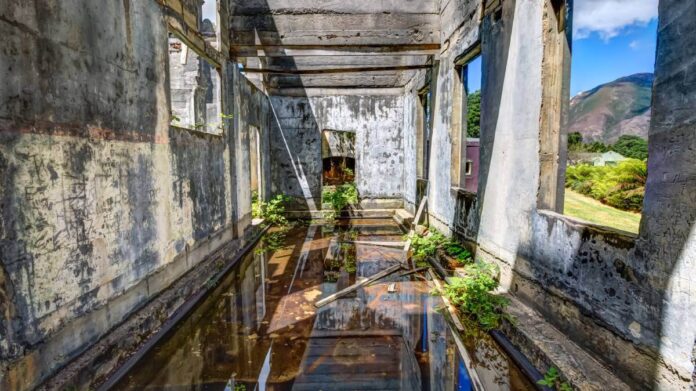Decaying houses, empty blocks, overgrown weeds and the faint remains of a gravel football field — welcome to Gormanston, a ghost town buried in the mountains of Tasmania’s wild west coast.
It’s just one community that has been made and undone at the whim of industry.
Ralph Burns, one of the town’s oldest surviving original inhabitants, ponders that as he walks the streets he grew up on.
The town was already past its heyday when he was young. By that time, just two of its eight pubs remained.
But what the 78-year-old sees now is an even further cry from the once-bustling mining town that had council chambers, a courthouse, jail, school, and mineshaft-turned-football oval.
“It’s a shame it’s been let go the way it’s been let go,” Mr Burns said.
In the early 1900s, Gormanston boasted a population of 2,000.
Now, it’s down to 32 — and that’s almost doubled in recent years, thanks to a handful of residents fighting to revive it.
Gormanston was the company town for the Mount Lyell Mining and Railway Company, the biggest player in the area.
On its boundary, less than a 10-minute walk away, was the Iron Blow, once a rich source of copper.
But when the mine was phased out in 1922, the focus shifted down the hill to neighbouring Queenstown, and to other ore bodies in the region.
“Mount Lyell was the breadwinner, as the old saying goes,” Mr Burns said.
“There was nothing much you could do about it being in a mining community, and you had to take it, take it or leave it.”
The population dwindled for decades, but it was further job cuts in the 1970s that delivered the final nail in the coffin.
“A lot of the retrenchments were from Gormanston and a lot of young ones with families moved away for employment, and the houses became vacant, so Mount Lyell started selling them off. People moved them all around Tasmania, picking them up on trucks,” Mr Burns said.
“A few [did] their best to keep [Gormanston] going, but eventually I think they just gave up, too.”
By 1980, the town didn’t even have a post office.
Princess River flooded for hydro power
Not too far away, another community was lost to make way for a different industry — hydroelectricity.
Its remnants are less obvious.
Just outside Queenstown, in a big tin shed filled with timber slabs of Huon pine, myrtle, sassafras and King Billy pine, Bern Bradshaw remembered where his family business began.
The now 94-year-old grew up over the mountains in Princess River, where his father established a sawmill in 1936, which Mr Bradshaw later took over.
But come the early 1990s, the small village was underwater — drowned to make way for Lake Burbury.
“The chap from the land department rang me [one] day and said, ‘We have to inform you that you have to leave’,” Mr Bradshaw said.
“I said, ‘I can’t afford to leave’, and they said, ‘You have to leave, it’s going to be flooded’.
“So, you know, the houses and the mill and everything like that had to be abandoned.
“There’s still an excavator out there that we weren’t allowed to remove.”
Although the business had been there for years, Mr Bradshaw said it ran on annual licences, which offered little security.
“I didn’t have any entitlement … I had no rights to stay there,” he said.
“But there was a moral obligation, I suppose, to ensure that the industry and the people weren’t just disowned altogether.”
Hundreds of towns ‘fade away’
Author and historian Michael Holmes has spent years studying the rise and fall of towns in Tasmania, — towns that remain “a shadow of their former selves”.
His tally is near 660. Of them, about 70 are on the west coast, mostly centred on industry or construction.
When an industry collapsed, Mr Holmes said a reliant town faced an inevitable fate.
“[The town] fades away, it vanishes,” Mr Holmes said.
“The primary reason is that they run out of resource, particularly in mining.
“The second one is changes in technology like cars replacing horses … telephone and internet have dramatically changed the circumstances. Or they finished building the railway or the dam.
“Obviously, they [can’t survive], the old adage about not putting all your eggs in one basket.”
Mr Holmes said modern work practices meant today’s towns weren’t as susceptible, but it came at a cost.
“The trend of fly in, fly out, means you don’t develop a community,” he said.
“Singles, usually males, fly in for the fortnight’s work and go home, go to somewhere else, and you don’t get the women and the kids and the football teams developing and the cricket teams.”
Towns rise and fall
Independent economist Saul Eslake said mining was one of Tasmania’s most important industries during federation but had shrunk over time, as resources were exploited, often to exhaustion.
Orbiting around one industry was inherently risky, and not unique to Tasmania.
“The fact that towns rise and fall … because their existence is dependent on a single commodity or a single mine, is something that’s been characteristic of human history down the ages,” Mr Eslake said.
He said two other west coast towns, Strahan and Queenstown, had reinvented themselves as tourist destinations.
“They’ve shown that a town can survive through circumstances that have brought about the death of other less-resilient communities.”
Zeehan had recently taken a hit with the closure of a 200-employee nickel mine but Mr Eslake believed it could cash in on growing renewable energy and tourism markets.
“I think the lesson is that towns and communities need to try, if they can, to have more than one string to their bow.”
Have you visited any of these ghost towns? Why not share your experience in the comments section below?
Also read: Get spooked in these creepy ghost towns

